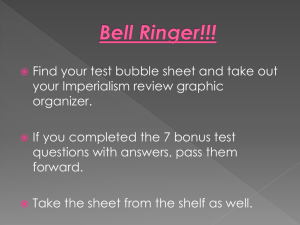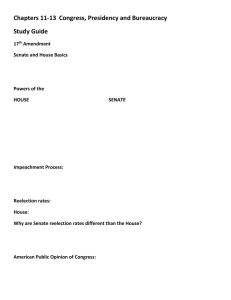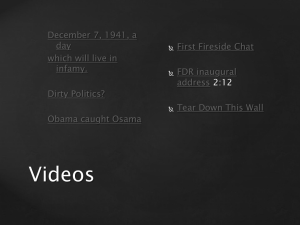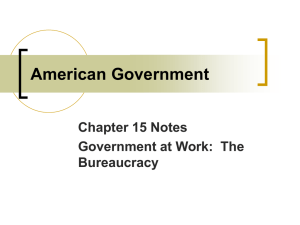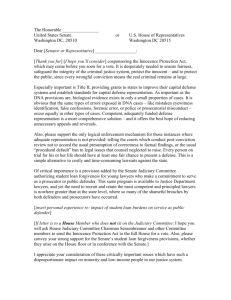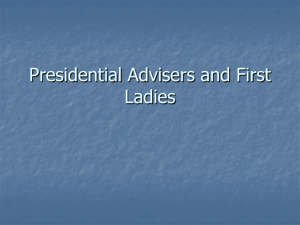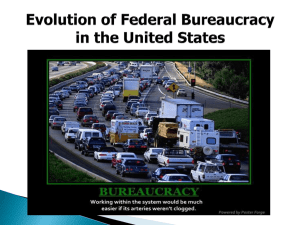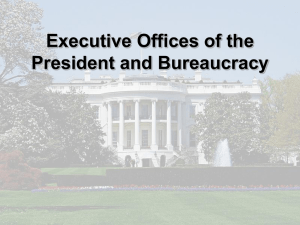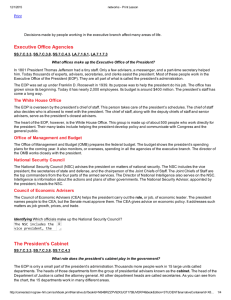Executive Branch Unit 7
advertisement
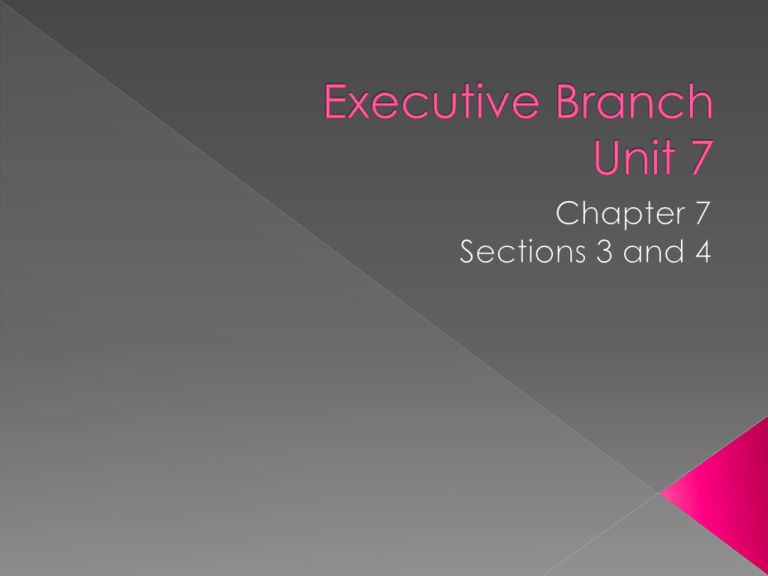
As Commander in Chief and Chief Diplomat, the president leads the nation’s armed forces and directs U.S. foreign policy. Foreign Policy – A nation’s plan for dealing with other nations. 4 Goals of Foreign Policy › Primary Goal: National Security: The ability to keep the country safe from attack or harm › 2nd: International trade › 3rd: Promoting World Peace › 4th: Promote democracy around the world Foreign Policy Team › State Department (Secretary of State) › Defense Department (Secretary of Defense) › Central Intelligence Agency (Director of the CIA) › National Security Council (National Security Advisor) › Joint Chiefs of Staff Congress v the President › President: Commander on Chief › Congress: Declare War Prohibit military action Spending – can spend or withhold money for defense Tools of Foreign Policy › Treaties and Executive Agreements Treaty: Formal agreements between two or more countries (needs Senate approval) Executive Agreement: Agreement between two or more heads of state (bypass Senate) › Appointing Ambassadors Ambassador: An official representative of a country’s government Embassy: A permanent diplomatic mission. Refers to the building or compound housing an ambassador's offices and staff. Tools of Foreign Policy (Con’t) › Foreign Aid Money, food, military assistance, other supplies › International Trade Trade sanctions: an effort to punish another nation by imposing trade barriers Embargo – agreement among a group of nations that prohibits them from trading with the target nation › Military Force Executive Office of the President (EOP) › Includes: White House Office (WHO) 500+ people Top Advisors of the President Most powerful: Chief of Staff Management and Budget (OMB) › Prepares the federal budget and monitors, or oversees, spending in hundreds of government agencies National Security Council › Helps the President direct United States military and foreign policy. › Includes: President, VP, Sec of State, Sec of Defense, Joint Chiefs of Staff, National Security Advisor Office of Administration › Provides administrative services to the EOP › Responds to individuals requesting information under the Freedom of Information Act Council of Economic Advisers (CEA) › Helps the President carry out his role as Economic Leader › Gives the President advice on complex economic matters such as employment, inflation, and foreign trade › President appoints the advisers with Senate consent. The Cabinet › Group of presidential advisers, that includes the heads of the 15 top-level executive departments › The heads of these departments are all called Secretaries with the exception of the head of the Department of Justice , which is referred to as the Attorney General The Cabinet 1. Department of State (1789): Plans and carries 2. 3. 4. 5. out the nation’s foreign policy. Department of the Treasury (1789): Collects, borrows, spends, and prints money Department of Defense (1789): Manages the armed forces Department of Justice (1870): Responsible for all aspects of law enforcement Department of the Interior (1879): Manages and protects nation’s public lands and natural resources 6. Department of Agriculture (1889): Assists farmers and consumers of farm products 7.Department of Commerce (1903): Supervises trade, promotes U.S. business, tourism 8. Department of Labor (1913): Deals with working conditions, wages of U.S. workers 9. Department of Health and Human Services (1953): Works for the well-being of all Americans 10. Department of Housing and Urban Development (1965): Deals with the special needs and problems of cities 11. Department of Transportation (1966): Manages the nation’s highways, railroads, airlines, and sea traffic 12. Department of Energy (1977): Directs the overall energy plan for the nation Department of Education (1979): Provides advice and funding for schools 14. Department of Veterans Affairs (1989): Directs services for armed forces veterans 15. Department of Homeland Security (2002): Oversees America’s defenses against terrorist attacks 13. The Federal Bureaucracy › Agencies, corporations, boards, and commissions that rank below the Cabinet departments › More than 3 million civilians › Bureaucrats or civil servants: the people that work for the above organizations 3 Goals of the Federal Bureaucracy › 1. Turn new laws into action by deciding how to apply the laws to daily life › 2. Departments and agencies administer the day-to-day operations of the federal government › 3. Federal agencies, with authority from Congress, regulate various activities Broadcasting companies, labor unions, banks, airlines, nuclear power plans etc. Independent Agencies: not part of the Cabinet › Executive Agencies Responsible for dealing with certain specialized areas within the government National Aeronautics and Space Administration (NASA) › Government Corporations Like a private business, except the government rather than individuals own and operate them President appoints a board of directors and a general manager to run each corporation with Senate approval › Regulatory Boards and Commissions Protects the public. They make and enforce rules for certain industries or groups. Federal Communications commissions (FCC) Government Workers › Political Appointees – Top leadership jobs. President chooses these positions (either because they are very qualified or because they were supporters of his campaign). Employment usually ends when the president leaves office. › Civil Service Workers – 90% of government employees. Permanent employees. Civil Service System – practice of hiring government workers on the basis of open, competitive examinations and merit. The Spoils System: jobs went to people as a reward for their political support “To the victor belong the spoils (jobs)” The Merit System: Standards set for federal jobs. Demanding tests are given to people who want those jobs. Government officials hire new workers from lists of people who have passed the tests or otherwise met civil service standards. The Pendleton Act – Created the civil service system and placed limits on the number of jobs that they president could “give out” to his friends, family and supporters
